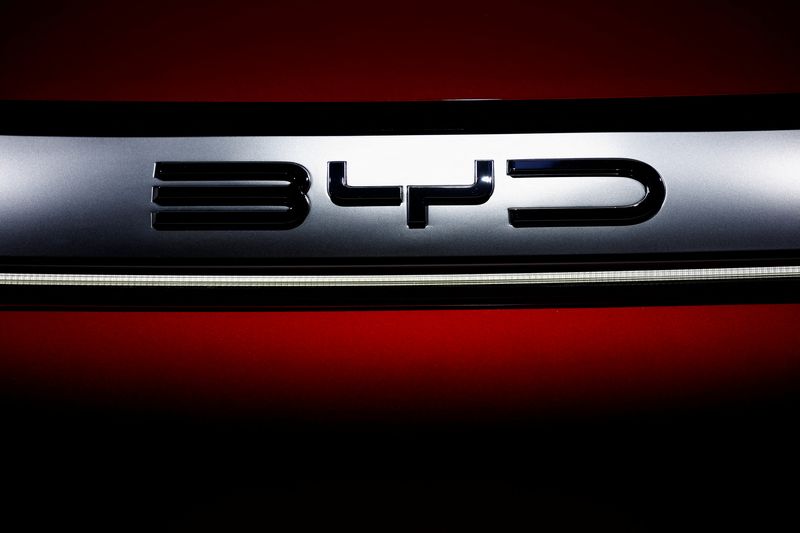Stella Qiu
SYDNEY (Reuters) – BYD and other Chinese automakers are bringing new electric vehicle models en masse to Australia, a market where they have not faced trade barriers and sales have risen thanks to EV subsidies and tax breaks and high gasoline prices.
Since coming to power in 2022, Prime Minister Anthony Albanese’s government has aggressively promoted the adoption of electric vehicles as part of the country’s plans to cut emissions – a change that comes after a decade of weak action on climate change under Conservative leaders.
This has created a strong tailwind for electric vehicle demand. Electric vehicles accounted for 7.2% of new car sales in Australia in 2023, up from 3.1% a year earlier.
While Tesla (NASDAQ:) is also a big beneficiary, it is Chinese manufacturers in the non-premium segment of the market that pose the greatest threat to existing automakers such as Toyota (NYSE:) and Ford (NYSE:), whose broad lineup of gasoline-powered vehicles means they have a lot to lose.
Last year, sales of electric vehicle giant BYD (SZ:), which will enter the market in 2022, grew almost sixfold to more than 12,000 vehicles. The Warren Buffett-backed automaker now has 14% of Australia’s electric vehicle market, second only to Tesla, which has 53%, according to the Federal Chamber of Automotive Industries.
“The opportunity is very clear,” said David Smitherman, chief executive of EVDirect, BYD’s distributor in Australia.
“Now we need to get into the mainstream market because we sell to early adopters and passionate EV buyers.”
BYD will add two SUVs and a pickup truck this year to increase its product line-up in Australia to six, Smitherman said. EVDirect will also open 30 more dealerships over the next 18 months (for a total of 55) and has begun selling fleets to companies like Uber (NYSE:).
Chinese state-owned SAIC Motor will launch three new models under its MG brand this year, including the MG3 plug-in hybrid and MG Cyberstar electric roadster, increasing its electric/hybrid range in Australia to five.
Incumbent automakers are also looking to up their game. Ford has two electrified vehicles in the Australian market and three more on the way, a company spokesperson said.
Toyota has just launched its first electric car, which joins its nine hybrids in Australia and offers lower emissions than comparable petrol-powered cars. The company is confident in its strategy to provide a wide range of hybrids and continuously increase the number of battery electric vehicles, it said.
“GIVE IT LET’S GET IT”
Although Australia is a relatively small market globally, with 1.2 million cars sold last year, it is very attractive to Chinese automakers given that it has no auto industry and is unlikely to impose protectionist trade barriers.
Chinese startup Leapmotor (HK:), which is partnering with Stellantis (NYSE:) for global expansion, has identified Australia as a priority market, noting the lack of local automakers there.
Tensions remain in key markets. European authorities have launched an investigation into whether Chinese electric car makers are unfairly benefiting from government subsidies, and the US has launched an investigation into whether Chinese-made cars could be used to spy on Americans.
But relations between Canberra and Beijing have warmed after years of tension, with both sides agreeing to turn the page and expand cooperation. The Albanese government has given no indication that it is concerned about the cybersecurity risks posed by Chinese cars.
Australia’s Department of Foreign Affairs and Trade declined to comment on the matter.
To stimulate demand for electric vehicles, the government has introduced tax incentives for lease/purchase agreements for electric vehicles available to some consumers through their employers.
The country’s three most populous states – Sydney, Melbourne and Brisbane – have also set a target for electric vehicles to account for 50% of all new car sales by 2030, offering generous rebates for EV purchases and investing heavily in building charging stations.
This was a major motivating factor for Mark Adamson, a 61-year-old television director from Queensland. He got A$6,000 ($3,900) off the A$54,000 retail price of his BYD Atto 3 extended range SUV through state government rebates, and then BYD offered a rebate of about A$2,000.
“I thought, why not give it a try? It’s really worth it because I have excess solar power at home, so I’ll mostly be charging from home, so it makes it easier in a lot of ways,” he said. .
Indeed, in Queensland, state government rebates alone mean the Atto 3 could cost less than Toyota’s RAV4 petrol crossover – a comparable model.
For Sydney union organizer Peter Alley, 63, who travels once a week to visit family 370 km (230 miles) away, it was the need to cut petrol costs near record levels that convinced him to ditch his 2008 Volkswagen. (ETR:) diesel van on Atto 3.
He now spends about A$20 a week on charging instead of $130 a week on fuel.
Expectations are high that demand for electric vehicles will continue to grow, although forecasts vary. PwC estimates that by 2027, half of new car sales in Australia will be electric vehicles. Fitch Ratings predicts that this figure will be 18% by 2032.
($1 = 1.5333 Australian dollars)


